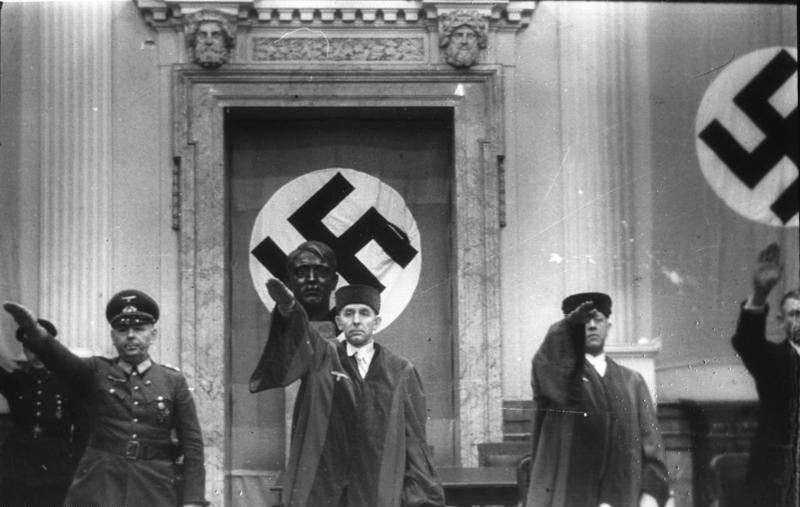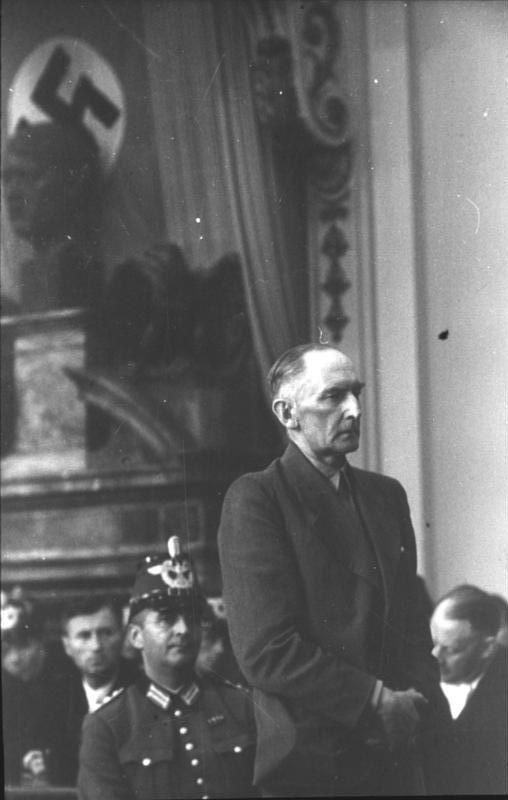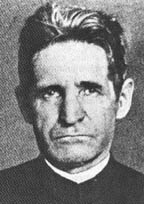|
Sondergericht
A ''Sondergericht'' (plural: ''Sondergerichte'') was a German "special court". After taking power in 1933, the Nazis quickly moved to remove internal opposition to the Nazi regime in Germany. The legal system became one of many tools for this aim and the Nazis gradually supplanted the normal justice system with political courts with wide-ranging powers. The function of the special courts was to intimidate the German public, but as they expanded their scope and took over roles previously done by ordinary courts such as '' Amtsgerichte'' this function became diluted. Function in Germany Special courts had existed in Germany as far back as the nineteenth century. They had generally been set up temporarily in response to some major but localised civil disturbance and then quickly dissolved once they had served their purpose. A more permanent national network of Special Courts came into being during 1933, soon after the passage of the Reichstag Fire Decree, which all but eliminat ... [...More Info...] [...Related Items...] OR: [Wikipedia] [Google] [Baidu] |
People's Court (Bavaria)
The People's Courts of Bavaria (') were ' (special courts) established by Kurt Eisner during the German Revolution in November 1918 and part of the Ordnungszelle that lasted until May 1924 after handing out more than 31,000 sentences. It was composed of two judges and three lay judges. One of its most notable trials was that of the Beer Hall Putsch conspirators, including Adolf Hitler, Erich Ludendorff, Wilhelm Frick, Friedrich Weber, and Ernst Röhm, which lasted from 26 February 1924 until 1 April 1924. Initially established in each court district by the Order of 16 November 1918 (') by the government of Kurt Eisner, it was furthered by the government of Johannes Hoffmann in the Law on the Establishment of People's Courts in Civil Disturbances of 12 July 1919 ('). An agreement between the federal government and the government of Bavaria had fixed the deadline for the abolition of the courts on 1 April 1924. In this form they remained until May 1924 after handing out more ... [...More Info...] [...Related Items...] OR: [Wikipedia] [Google] [Baidu] |
People's Court (Germany)
The People's Court (german: Volksgerichtshof, acronymed to ''VGH'') was a ' ("special court") of Nazi Germany, set up outside the operations of the constitutional frame of law. Its headquarters were originally located in the former Prussian House of Lords in Berlin, later moved to the former '' Königliches Wilhelms-Gymnasium'' at Bellevuestrasse 15 in Potsdamer Platz (the location now occupied by the Sony Center; a marker is located on the sidewalk nearby). The court was established in 1934 by order of Reich Chancellor Adolf Hitler, in response to his dissatisfaction at the outcome of the Reichstag fire trial in front of the Reich Court of Justice (''Reichsgericht'') in which all but one of the defendants were acquitted. The court had jurisdiction over a rather broad array of "political offenses", which included crimes like black marketeering, work slowdowns, defeatism, and treason against Nazi Germany. These crimes were viewed by the court as ''Wehrkraftzersetzung'' ("the dis ... [...More Info...] [...Related Items...] OR: [Wikipedia] [Google] [Baidu] |
Martin Niemöller
Friedrich Gustav Emil Martin Niemöller (; 14 January 18926 March 1984) was a German theologian and Lutheran pastor. He is best known for his opposition to the Nazi regime during the late 1930s and for his widely quoted 1946 poem " First they came ...". The poem exists in many versions; the one featured on the United States Holocaust Memorial reads: "First they came for the Communists, and I did not speak out—Because I was not a communist. Then they came for the trade unionists, and I did not speak out—Because I was not a trade unionist. Then they came for the Jews, and I did not speak out—Because I was not a Jew. Then they came for me—and there was no one left to speak for me." Niemöller was a national conservative and initially a supporter of Adolf Hitler and a self-identified antisemite,Michael, Robert. Theological Myth, German Antisemitism, and the Holocaust: The Case of Martin Niemoeller, Holocaust and Genocide Studies.1987; 2: 105–122. but he became one of the ... [...More Info...] [...Related Items...] OR: [Wikipedia] [Google] [Baidu] |
Artur Dinter
Artur Dinter (27 June 1876 – 21 May 1948) was a German writer and Nazism, Nazi politician who was the ''Gauleiter'' of Gau Thuringia. Biography Dinter was born in Mulhouse, in Alsace-Lorraine, German Empire (now France) to Josef Dinter, a customs adviser, and his wife Berta, née Hoffmann, and he was baptized in the Catholic Church. After doing his school-leaving examination, Dinter began studying natural sciences and philosophy in 1895 at the Ludwig Maximilian University of Munich and at the University of Strasbourg. From 1901 to 1903, he worked as a chemistry assistant at the University of Strasbourg. He graduated in 1903 summa cum laude. Already while he was studying, he had been undertaking endeavours as a writer. His 1906 play ''Die Schmuggler'' ("The Smugglers") was awarded a first prize. After graduation, Dinter was director of the botanical school garden in Strasbourg. In 1904, as a senior teacher at Deutsche Schule Istanbul, a German school, he went to Constantinop ... [...More Info...] [...Related Items...] OR: [Wikipedia] [Google] [Baidu] |
Nazi Regime
Nazi Germany (lit. "National Socialist State"), ' (lit. "Nazi State") for short; also ' (lit. "National Socialist Germany") (officially known as the German Reich from 1933 until 1943, and the Greater German Reich from 1943 to 1945) was the German state between 1933 and 1945, when Adolf Hitler and the Nazi Party controlled the country, transforming it into a dictatorship. Under Hitler's rule, Germany quickly became a totalitarian state where nearly all aspects of life were controlled by the government. The Third Reich, meaning "Third Realm" or "Third Empire", alluded to the Nazi claim that Nazi Germany was the successor to the earlier Holy Roman Empire (800–1806) and German Empire (1871–1918). The Third Reich, which Hitler and the Nazis referred to as the Thousand-Year Reich, ended in May 1945 after just 12 years when the Allies defeated Germany, ending World War II in Europe. On 30 January 1933, Hitler was appointed chancellor of Germany, the head of government, ... [...More Info...] [...Related Items...] OR: [Wikipedia] [Google] [Baidu] |
Bundesarchiv Bild 151-39-23, Volksgerichtshof, Reinecke, Freisler, Lautz
, type = Archive , seal = , seal_size = , seal_caption = , seal_alt = , logo = Bundesarchiv-Logo.svg , logo_size = , logo_caption = , logo_alt = , image = Bundesarchiv Koblenz.jpg , image_caption = The Federal Archives in Koblenz , image_alt = , formed = , preceding1 = , preceding2 = , dissolved = , superseding1 = , superseding2 = , agency_type = , jurisdiction = , status = Active , headquarters = PotsdamerStraße156075Koblenz , coordinates = , motto = , employees = , budget = million () , chief1_name = Michael Hollmann , chief1_position = President of the Federal Archives , chief2_name = Dr. Andrea Hänger , chief2_position ... [...More Info...] [...Related Items...] OR: [Wikipedia] [Google] [Baidu] |
Adolf Hitler
Adolf Hitler (; 20 April 188930 April 1945) was an Austrian-born German politician who was dictator of Nazi Germany, Germany from 1933 until Death of Adolf Hitler, his death in 1945. Adolf Hitler's rise to power, He rose to power as the leader of the Nazi Party, becoming the Chancellor of Germany, chancellor in 1933 and then taking the title of in 1934. During his dictatorship, he initiated European theatre of World War II, World War II in Europe by invasion of Poland, invading Poland on 1 September 1939. He was closely involved in military operations throughout the war and was central to the perpetration of the Holocaust: the genocide of Holocaust victims, about six million Jews and millions of other victims. Hitler was born in Braunau am Inn in Austria-Hungary and was raised near Linz. He lived in Vienna later in the first decade of the 1900s and moved to Germany in 1913. He was decorated during his Military career of Adolf Hitler, service in the German Army in Worl ... [...More Info...] [...Related Items...] OR: [Wikipedia] [Google] [Baidu] |
Journal Of Modern History
''The Journal of Modern History'' is a quarterly peer-reviewed academic journal covering European intellectual, political, and cultural history, published by the University of Chicago Press. Established in 1929, the journal covers events from approximately 1500 to the present, with a geographical scope extending from the United Kingdom through the European continent, including Russia and the Balkans. Editors and editorial board The ''Journal of Modern History'' is coedited by John W. Boyer, Jan E. Goldstein, and Fredrik Albritton Jonsson (University of Chicago). Previous editors include Sheila Fitzpatrick, Hanna Gray, William Hardy McNeill, and Bernadotte Schmitt. Format and contents The journal publishes articles and book reviews. On occasion, it has published special issues focusing on specific topics. The Chester Penn Higby Prize Chester Penn Higby (1886–1966) served on the history faculty at the University of Wisconsin–Madison from 1927 to 1956, and was one of ... [...More Info...] [...Related Items...] OR: [Wikipedia] [Google] [Baidu] |
Nacht Und Nebel
''Nacht und Nebel'' (German: ), meaning Night and Fog, was a directive issued by Adolf Hitler on 7 December 1941 targeting political activists and resistance "helpers" in the territories occupied by Nazi Germany during World War II, who were to be imprisoned, murdered, or made to disappear, while the family and the population remained uncertain as to the fate or whereabouts of the alleged offender against the Nazi occupation power. Victims who disappeared in these clandestine actions were never heard from again. Name The alliterative hendiadys ''Nacht und Nebel'' (German for "Night and Fog") is documented in German since the beginning of the 17th century. It was used by Wagner in ''Das Rheingold'' (1869) and has since been adopted into everyday German (e.g. it appears in Thomas Mann's '' Der Zauberberg,'' or "The Magic Mountain"). It is not clear whether the term ''Nacht-und-Nebel-Erlass'' ("Night and Fog directive") had been in wide circulation or used publicly before 1945. Th ... [...More Info...] [...Related Items...] OR: [Wikipedia] [Google] [Baidu] |
Paul Ogorzow
Paul Ogorzow (29 September 1912 – 26 July 1941), was a Germans, German serial killer and rapist, known as The S-Bahn Murderer, convicted for the killing of eight women in Nazi Germany, Nazi-era Berlin between October 1940 and July 1941.Selby, Scott Andrew (2014).�''A Serial Killer in Nazi Berlin: The Chilling True Story of the S-Bahn Murderer''.Berkley Publishing Group. During the height of World War II, Ogorzow was employed by , working for the Berlin S-Bahn, S-Bahn commuter rail system in Berlin. Using the routine Blackout (wartime), wartime blackouts intended to hinder Bombing of Berlin in World War II, Allied bombing, Ogorzow committed serial rape and murder against women in the city over a nine-month period until his arrest by the . He was executed at Plötzensee Prison. Background Early life Paul Ogorzow was born on 29 September 1912 in the village of Muntowo, Muntowen, East Prussia, German Empire (present-day Muntowo, Poland), the Legitimacy (family law), illegitimate ... [...More Info...] [...Related Items...] OR: [Wikipedia] [Google] [Baidu] |
Rupert Mayer
Rupert Mayer (23 January 1876 – 1 November 1945) was a Germans, German Jesuit Priesthood (Catholic Church), priest and a leading figure of the Catholic German Resistance to Nazism, resistance to Nazism in Munich. In 1987, he was beatified by Pope John Paul II. Early life Mayer was born and grew up in Stuttgart, one of five siblings. He finished his secondary education in 1894 and studied philosophy and theology in Freiburg, Switzerland; Munich and Tübingen. He was, among other things, a member of ''A.V. Guestfalia Tübingen'' and ''K.D.St.V. Aenania München'', two ''Studentenverbindungen'' that belong to the ''Cartellverband der katholischen deutschen Studentenverbindungen''. In 1899, he was ordained a priest and served for a year as an assistant pastor in Spaichingen before joining the Society of Jesus in Feldkirch, Vorarlberg, Austria (then Austria-Hungary) in 1900. After his novitiate, he went to the Netherlands for further studies between 1906 and 1911, and then moved ab ... [...More Info...] [...Related Items...] OR: [Wikipedia] [Google] [Baidu] |





